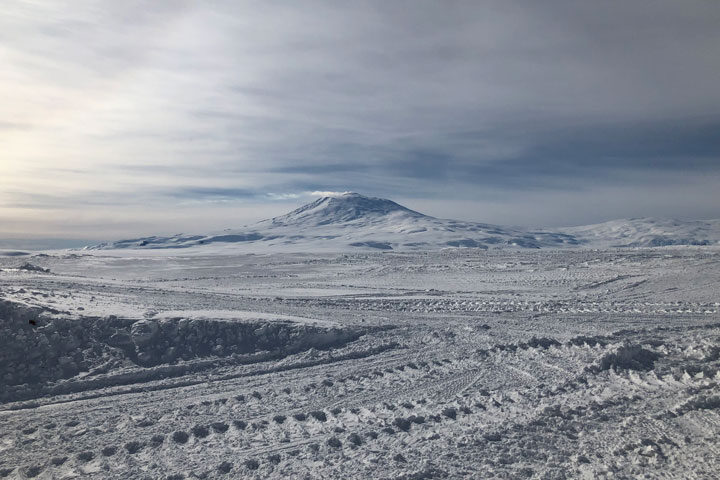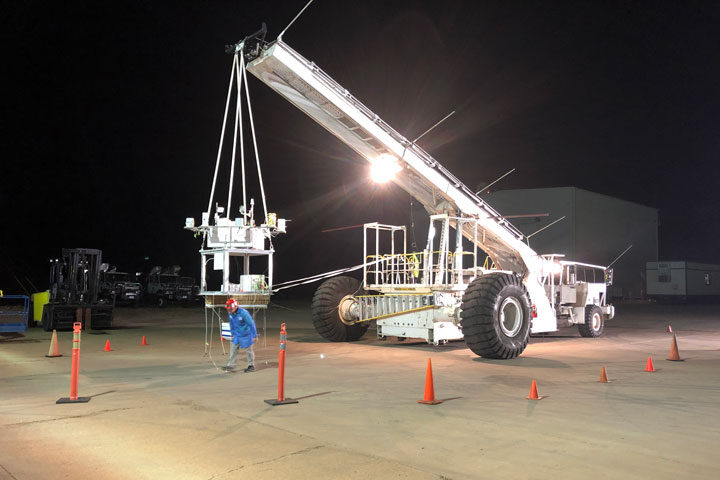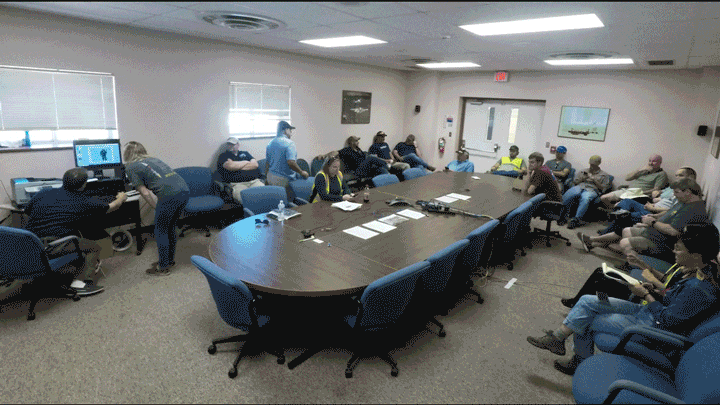


So, I realize it’s been awhile since I’ve managed an update from the balloon blogging scene, but hopefully this will help make up for it. Since I left you in New Mexico, the Balloon Program Office finished out our domestic campaign coming out with a very successful group of flights. But, finishing up there wasn’t the end of our operations for 2019.
Right now, your intrepid engineer is currently deployed to McMurdo Station, Antarctica, to support launch operations from one of the most remote locations on the planet. So you know, that’s pretty cool … get it? We’re in the process of gearing up for our launches here at the Long Duration Balloon Camp just outside McMurdo. We’re going to be conducting a few smaller balloon flights and then a couple of our big balloons. I’ll send out some more details over the next few days.
The question I regularly get about why the Balloon Program comes to Antarctica is why do we launch balloons from the South Pole? Well, we come down here because, quite frankly, there is no other place like it. During the austral summer (that’s a fancy way of saying when the Northern Hemisphere is in winter and the Southern Hemisphere is in their summer), the Sun never sets here, so no matter what time you go outside, it looks like it’s about 11 o’clock in the morning. And since the Sun is always shining, our balloons are able to stay at the same altitude and fly for many weeks before they need to be brought down. Last year we had a flight that flew for 73 days!
Another thing that makes Antarctica special for balloon launches is that the Van Allen radiation belts are at a much lower altitude near the pole of the planet. The Van Allen Belts are kind of like a magnetic bottle around the Earth that protect it from solar (from the Sun) and cosmic (from way outside our solar system) rays. The Van Allen radiation belts can also interfere with some of our scientists’ instruments when they’re conducting experiments from most other places around the world. But, down here in Antarctica, just like the North Pole, the Van Allen radiation belts are very weak, so when our scientists fly from here they are able to get images and measurements in greater detail than anywhere else.
Antarctica is truly a strange, new world where you can see and experience new, exciting things. The photo I’ve attached today is of Mount Erebus, our friendly neighborhood volcano, which was discovered by James Ross in 1841 and was named after one of his two ships, the H.M.S Erebus.
Thanks again for checking back!
Jason Budinoff, an aerospace engineer, cocked his head, listening for the sound of metal on metal. “Can you hear it?” someone asked. The room quieted, and a soft, tinny buzz whined from the instrument at the center of the crowd. Inside, a small electric motor was spinning.
It was three weeks before launch, and the BITSE team was testing the door on their instrument, which was almost ready for its balloon flight to the top of the sky. Eventually, BITSE successfully flew on Sept. 18. But the work toward its launch started a couple years earlier — and continued with tests of each detail up to the very last weeks before launch. One key element: the door.
Slightly larger than a pie, BITSE’s door works like the lens cap on a camera to protect the instrument’s sensitive optics. Instead of scratches, it shielded BITSE from dust and bugs that could fly in during ascent. Once it climbed to float altitude, 22 miles up in much less dusty skies, the door opened and BITSE began taking pictures of the Sun.
The BITSE balloon flight put a new coronagraph to the test, a kind of instrument that looks at the Sun’s dim atmosphere. The BITSE tech — short for Balloon-borne Investigation of Temperature and Speed of Electrons in the corona — is designed to look for clues to how the solar wind forms. That’s the stream of charged particles constantly blowing off the Sun. The solar scope takes images in certain wavelengths of light that are especially prone to scattering off dust, marking data with distracting bright spots. “The cleaner we are, the better science we’ll get,” said Budinoff, BITSE’s lead mechanical engineer.
That morning was as much a test of the team’s nerves as it was of the door. It was the last time they’d run it before launch, and BITSE was decked out in flight configuration.
Software engineer Seonghwan Choi and his team wrote the code that tells BITSE to open sesame. They work for the Korea Astronomy and Space Science Institute, NASA’s partner in the BITSE mission. “If the software doesn’t work and the door doesn’t open, the mission will fail!” Choi said. He laughed nervously at the idea. Take a picture with a camera but forget to remove the lens cap first, and you just get the void — no data.
By then, they’d already done the test at least eight times. This was BITSE’s biggest audience yet, since the entire team was gathered at NASA’s Columbia Scientific Balloon Facility’s New Mexico field site for the coming launch. “When literally the entire mission is saying, ‘Your door better work!’ — the more we test the door, the better,” Budinoff told me. “I’d do it 50 more times if I could.”
It works like this: A one-centimeter-long pin — about the width of a fingernail — keeps the door latched shut, while a screw moves the pin back and forth. When BITSE receives the word, a tiny motor starts running and the screw starts turning. And that pulls the pin out from the latch, allowing the spring-loaded door to flip open. The entire thing hinges — literally — on the pin moving just half a centimeter. From sending the command to opening the door, it all takes no more than 45 seconds.
A few minutes before the test, the team gathered in front of BITSE. Scientists brought their phones out to film it. I did the same. “It’s not going to be nearly as exciting as everyone is thinking,” Budinoff warned.
Regardless, someone began a countdown. (We at NASA love a good countdown.) “Here it comes!” another called. BITSE buzzed for a brief moment, and the door fell open with a neat, hollow thunk. Satisfied, Budinoff started a round of applause.
Later, they ran a second test. It looked just like the first one, but there was one key difference. Instead of sending a command, the software team let BITSE guide itself. This was the back-up plan in case they lose contact with BITSE. Without instructions from the ground, the coronagraph was programmed to open its own door after a few hours — the amount of time it would take the 6,000-pound load to ascend 22 miles. Even if it couldn’t hear the team, BITSE would dutifully stick to the plan.
After the second test, while the door was still open, the engineers took the opportunity to vacuum BITSE’s mouth. They used an ultraviolet flashlight to spot individual specks of dust, which pop in electric blues and greens under the light. With the door thoroughly tested and the tidying done, it was time to shut it one last time. The software team ran the program backwards, turning the screw the opposite direction so it pushed the pin into the latch. We listened again for motor’s high-pitched whine. “Hopefully the next time we open, we’ll be 120,000 feet in the air,” Budinoff said.
In the end, their worrying, testing and re-testing was worth it: On Sept. 18, BITSE’s door opened like a charm.

First off, I want to thank Lina Tran, Joy Ng, and Chelsey Ballarte for putting together the last post here at the “Balloons for Science” blog. And it just goes to show how much better it is when you don’t let the engineer do the writing. But, with that said, the engineer is back at the keyboard, so good luck!
Anywho, it’s been a couple of weeks since I’ve had a chance to put out some more information so I wanted to give an update from the field. Just recently, Joe Mitchell, my very good colleague and mission manager extraordinaire has successfully launched three additional flights from Ft. Sumner. That’s a really great thing for our scientists. Our latest payloads that we flew were the 11 MCF Piggy-back flight, the High Altitude Student Platform (HASP), and the BITSE. You might remember me talking about BITSE a couple of posts ago in “Nothing but Blue Skies Are All That I See.” All three flights flew nominally, which to us engineers means it flew just as expected. Then another good colleague of mine, Alan Haggard, the Balloon Program’s most experienced mission manager, just launched another balloon today. This time it was an engineering demonstration flight, Long Duration Balloon (LDB) Test Flight, for a bunch of new instrumentation that’ll be used on our next Super Pressure Balloon flight!
So that brings us up to five launches from Ft. Sumner this year and we still have a couple to go. I’m also going to be covering a few more topics this campaign and bringing you updates from the field. Today, I want to leave you with this from one of my favorite authors:
“I see that it is by no means useless to travel, if a man wants to see something new.”
― Jules Verne, Around the World in 80 Days
Every time we fly a balloon, we’re seeing something brand new. Thanks again and check back real soon.
It’s 1:30 p.m. MT, and scientists and engineers at NASA’s Columbia Scientific Balloon Facility’s field site file into a meeting room. Time for the weather briefing. It’s standing room only — the biggest group of people I’ve seen yet in my week in Fort Sumner, New Mexico, population roughly 1,000.
Daily weather briefings give rhythm to otherwise irregular days filled with launch attempts and instrument tests. Everyone is here to send balloons to the top of the sky; this daily meeting is where the decisions are made about whether we’ll try to do it the next morning. Since launch preparations begin around 2 a.m., this is when I learn whether I need to set my alarm for 12:30 a.m., six hours earlier than usual.

I’m a NASA writer, here with a team of scientists and engineers launching a solar scope called BITSE, which is testing a new way to see the Sun. BITSE — short for Balloon-borne Investigation of Temperature and Speed of Electrons in the corona — is a coronagraph, a kind of instrument that peers at the Sun’s dim atmosphere, the corona. BITSE will search for clues to how the solar wind, the stream of charged particles constantly blowing from the Sun, forms there.
To me, it seems the most challenging thing about launching scientific balloons is the weather. It has to be just right in an entire chunk of sky: from the ground where the balloon launches, through the long stretch of blue where it ascends, to some 22 miles up where it floats. The balloon also needs consistent winds and fair skies along its projected flight path, which spans hundreds of miles and changes every day — depending on the weather, of course.
“Basically, we can’t have wind at the surface when we lay out the balloon,” NASA mission manager Amy Canfield explained. “Then, when the balloon is inflated, we want light low-level winds, so the balloon ascends nice and calm, straight up. The weather can change just like” — she snapped — “that. If it changes, we have to scrub for the day.”

In Fort Sumner, a town in the desert 4,000 feet above sea level, late summer is hot, and the wind blows like a hair-dryer on low. Fort Sumner, which sits in the waist of New Mexico, is well-positioned for balloon launches. It’s remote, about an hour drive to the next town in any direction. Ascending balloons aren’t likely to stray too far north into the Rocky Mountains or too far south into Mexico.

BITSE passed its final test before launch, so now we’re just waiting for good weather. Waiting each day to learn whether BITSE will get a chance to fly that night is nerve-wracking. One of the scientists on the team likened our seemingly endless wait to life in the movie Groundhog Day.
Several times, thunderstorms hundreds of miles away kept BITSE grounded. The air above a thunderstorm is cold, so when a balloon passes overhead, you get balloon droop. The helium inside shrinks from the chill and the balloon plunges — bad news for the team if that cuts the flight short or drops BITSE into a rough storm.
Another time, had BITSE launched, the winds would have carried it on a grand tour of pretty much every population center between Fort Sumner and eastern Arizona, which safety regulations won’t permit. Often, gusting winds on the ground prevented smooth unrolling of the balloon. “If you feel wind blowing in your face, we’re not launching a balloon,” NASA mission operations manager Andy Hynous said.
The balloon program in Fort Sumner also takes advantage of what’s called the Turnaround — a stratospheric weather pattern that has the upper atmospheric winds blowing east to west the first half of the year and west to east in the second. Each fall balloon campaign takes place during the last weeks of east-to-west winds, just before the Turnaround. They send balloons west, into a part of the country where there are vast swathes of open, uninhabited land.
The meteorologist working on the balloon campaign says most other meteorologists don’t care what happens in the stratosphere since it doesn’t touch our lives, far below. But for science instruments, the region offers the chance to show their mettle above most of Earth’s atmosphere. Scientists gain access to measurements and tests they can’t do on ground-based instruments. For BITSE, flying 22 miles up means studying the Sun’s dim atmosphere with much less interfering light than it would experience from the ground. The flight could also pave the way for an instrument descendant of BITSE’s to potentially do the same science from space one day.
After the weather update, NASA mission range safety officer Lauren Morgan presents her assessment of risks in the projected flight path. Besides good weather, BITSE also needs a thumbs-up from safety to fly. She considers a number of factors to ensure a safe flight. How many towns or cities would the balloon fly over? Which airports need to be alerted? Then, at the end of the flight, when BITSE parachutes down, she’ll consider whether the recovery team — which meets BITSE and brings the 6,000-pound load back to Fort Sumner — can safely drive into potential landing spots. She wants to avoid towns and cities, national parks and wilderness areas, public infrastructure like wind farms, and even the delicate habitats of endangered species.
Day by day, the team will keep presenting new forecasts and projections, searching for a window just right for BITSE’s flight. Until then, the only thing for us to do is keep waiting for the winds to align.

I’d like to welcome you back to the ballooning extraordinaire blog. As is normally the case, the weather in Ft. Sumner has been gracious enough for us to conduct our first successful flight of the campaign. Our first flight was conducted by the BOBCAT team. You can see in the photo (below) the payload gondola and our Mobile Launch Vehicle beautifully backlit by the New Mexican sunrise. The gondola is the structure that carries all the stuff that the science team needs to make their experiment work. The BOBCAT mission is a testbed demonstration for a cool, new type of cryogenic liquid containment system for balloon-borne telescopes. A lot of people might not know that cryogenic liquids are gases that have been cooled and compressed for so long that they actually turn into a liquid.
Our balloons at NASA use helium as a gas to rise from the ground, just like your run of the mill party balloons from the store, and they end up flying pretty good. But sometimes the science instruments we fly also use helium and other gases to protect their telescopes and detectors from moisture, particles in the air, and other stuff like that. Here’s where the “cool” part comes in. Sometimes the instruments need to be kept really, really cold. To do that, they use cryogenic helium and nitrogen liquids. At standard pressure, like here on the ground, liquid helium is 4 Kelvin. In Celsius, that’s -269 degrees. That’s pretty darn cold. The equipment to keep gases like helium that cold are usually pretty bulky and heavy. Dr. Alan Kogut, from the Goddard Space Flight Center, has figured out a way to make that equipment a lot lighter, which means that the instruments will be able to fly longer and higher then they would have.

In total, BOBCAT flew a total 4.5 hours at an altitude of over 125,000 feet. BOBCAT gracefully flew from Ft. Sumner, New Mexico all the way to just outside Sanders, Arizona. We couldn’t have asked for a better flight. Thanks again for checking out this update, and look for another real soon!